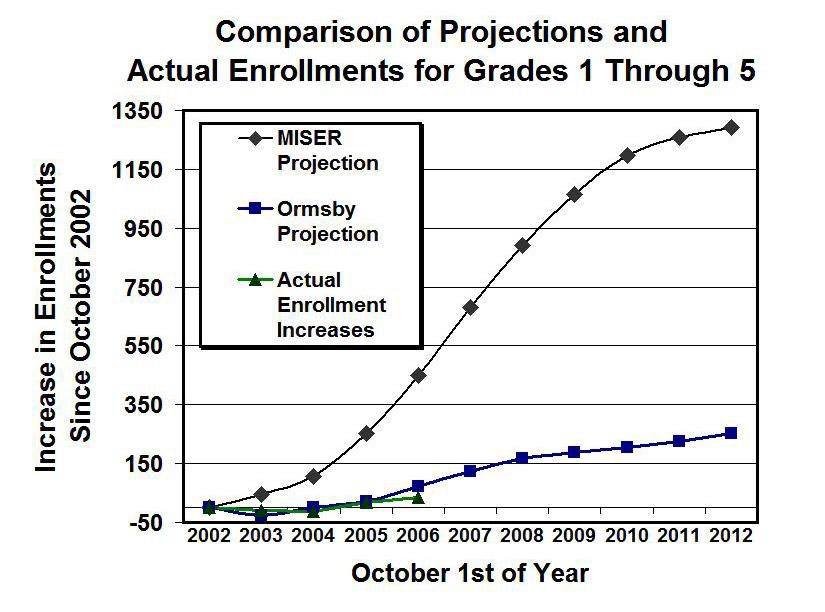>>Valley Patriot>>
|

Foster
Farm Ripoff, Time to Fess Up?
Ralph Wilbur with Tedd Tripp
 The decade-long saga of the Foster
Farm School effort has finally come to a close. After
frittering away millions of dollars over the years, the
North Andover School Committee – against some
members’ personal wishes - has reluctantly decided
not to pursue the building of this new elementary school.
The untold story is that the school department’s
projections of over one thousand new elementary school
students flooding into an overcrowded system proved to be
pure fiction. The decade-long saga of the Foster
Farm School effort has finally come to a close. After
frittering away millions of dollars over the years, the
North Andover School Committee – against some
members’ personal wishes - has reluctantly decided
not to pursue the building of this new elementary school.
The untold story is that the school department’s
projections of over one thousand new elementary school
students flooding into an overcrowded system proved to be
pure fiction.
In May 2002, the annual town meeting appropriated $2.3
million to begin a design study for the new school. The
justification for the design expenditure was based on an
enrollment study by the MISER organization, as requested
by then Superintendent Bill Allen and School Committee
members Diane Huster, Dan Murphy, Bruce Baker, Don
Sternfeld and Al Perry. MISER, which no longer exists,
was an educational research organization that contracted
out its services to various school districts.
The MISER study conveniently showed that a “massive
increase” in enrollments was to be expected. A
parallel facilities study concluded that the elementary
schools would be 39 to 44 classrooms short for the
2005/2006 school year and an incredible 81 to 85
classrooms short for the 2011/2012 school year. The
overall inference, not surprisingly, was that North
Andover was in desperate need of a new 880-student Foster
Farm Elementary School.
The 2002 town meeting also called for a $4 million
Proposition 2 ½ Override with most of that money going
to the operational budget of the schools.
A month later this proposed tax increase was soundly
defeated by the voters and all those discussions about
the override caused some members of  the community to begin taking a
closer look at the school’s never-ending appetite
for more money. One of those taking an interest was North
Andover Taxpayers Association member Chuck Ormsby. the community to begin taking a
closer look at the school’s never-ending appetite
for more money. One of those taking an interest was North
Andover Taxpayers Association member Chuck Ormsby.
In September of 2002, when the actual school enrollment
figures were announced, Ormsby noticed that there was a
reduction in elementary students from the previous year,
rather than the increase predicted by MISER and the
school administration. Ormsby, who was then not yet on
the School Committee, requested a delay in the spending
of the $2.3 million until there was a full review of the
enrollment projections and facility needs.
Ormsby had also independently developed a mathematical
model to project future enrollments based on enrollment
history, births and new growth.
The results were quite startling: The Ormsby data showed
that K-5 enrollments would increase very slowly if at all
over the coming decade. It further showed that the
enrollment would be 538 students short of what MISER
projected for October 2006.
By October of 2011, the Ormsby numbers showed MISER to be
1203 students beyond what could be expected. Clearly,
someone was fudging the numbers.
In an October 2002 School Committee meeting, Ormsby
presented his findings in a 45-minute slide show on his
methodology and the results. During the presentation,
Diane Huster, a member of the School Facilities Master
Plan Committee and a leader in Taxpayers United for the
Future (TUFF), mocked Ormsby’s conclusions and data.
And afterwards, Chairman Dan Murphy rose and said, “Well,
we didn’t learn anything new tonight.”
Now then … whose projections were correct? The
nearby figure shows a comparison of (1) the School
Committee’s projected enrollment increases from
MISER for grades one through five, (2) Ormsby’s 2002
projections, and (3) the actual enrollment increases for
2003 through 2006. You can see that the Ormsby
projections are almost indistinguishable from the actual
enrollment increases while the School Committee
projections were off by hundreds of students.
Note that for 2006 the MISER projected estimate is 415
students over the actual number that showed up this year.
(Including kindergarten, MISER was high by a whopping 609
students!)
This begs the obvious questions: Are we looking at gross
negligence here? Or could it be intentional deception to
justify a new school? Either way, we are looking at
$23-35 million in taxpayers’ money that could have
been wasted if Ormsby had not intervened.
Up until the recent October 2006 meeting at which the
School Committee finally cancelled the Foster Farm
project, the School Building Committee had already spent
- or wasted - about $1 million of the $2.3 million in
funds the taxpayers had generously appropriated. This
money is gone forever.
So, have the profligate-spending school advocates learned
anything from this experience? Probably not. In the
several months leading up to the cancellation, the School
Building Committee actually commissioned a new study with
a consulting firm to see if there was any chance in
justifying going ahead with the project anyway. Although
several members of the SBC felt construction of the
school was probably unwarranted, it is hard to understand
why the committee still felt compelled to spend the
taxpayers’ money for an unneeded school.
In this new study, the consultants assumed in their
calculations that the Bradstreet School would be
unavailable, that the town would sponsor a full-day
kindergarten program, that portable classrooms would not
be used, and that classrooms would have not more than 18
students in kindergarten and 22 in grades 1st through
5th. With these assumptions, the consultants created a
case for a new school.
Ormsby reworked their assumptions and came up with a
different conclusion. If the Bradsteet School is
reopened, if the kindergarten enrollments can be
moderated, and if class sizes of 18 in kindergarten, 22
in 1st grade, 24 in 2nd, 26 in 3rd, and 28 in 4th and 5th
are allowed, then our current facilities will accommodate
500 more students than the consultants’ analysis.
This satisfies the realistic, projected enrollments over
the next decade, even with no portable classrooms and
still allowing for kindergarten space along the lines of
current enrollment.
The end result is this: While a brand-spanking new school
would be nice, there never was any justification to
pursue the expenditure of $23-35 million of taxpayers’
money on a new school project. The millions that have
been spent so far could have much more effectively been
used on textbooks, curriculum initiatives, science labs
and other critical school items currently in short
supply.
Those who supported this ill-advised venture and who
ignored honest enrollment projections should confess
their sins. But don’t hold your breath.
Public officials need to learn that their job is not to
be a biased advocate for some special interest group.
Their job is to be an honest broker of the facts and
present to the citizens an even-handed assessment of the
situation in order that a rational, unbiased decision can
be made in the best interests of the entire community.
Ralph Wilbur is a member of
the North Andover Taxpayers Association, owner of Graphic
Litho and vice president of Valley Patriot Inc. You can
email him at sales@graphiclitho.com.
*Send your questions comments to ValleyPatriot@aol.com
The December, 2006
Edition of the Valley Patriot
The Valley Patriot is a Monthly
Publication.
All Contents (C) 2006, Valley Patriot, Inc.
We publish 10,000 newspapers and distribute in Andover,
North Andover,
Methuen, Haverhill, Chelmsford, Georgetown, Groveland,
Boxford,
Lawrence, Dracut, Tewksbury, Hampton & Salisbury
Beach, and Lowell.
|

Valley Patriot Archive
Valley Patriot Story
ARCHIVES
Prior Lead
Stories
Prior
Valley Patriot Editorials
Prior Columns by ...

Tom Duggan
Dr. Chuck
Ormsby
Paula
Porten
Ralph
Wilbur
Hanna
Ted Tripp
Valley
Patriot of the Month
Griselsilva.com
Patrick
Blanchette
D.J.
Beauregard
Jim
Cassidy
D.J. Deeb
Marcos
Devers
Bob
Desmarais
Regina
Faticanti
Jim
Fiorentini
Bill Kelly
Wilfredo
Laboy
Peter
Larocque
Vilma Lora
Ed Maguire
Billy
Manzi
Paul
Murano
Mark
Palermo
Hartley
Pleshaw
Debbie
Quinn
Raise Em
Right
Dr. Peary
Kathleen
Corey Rahme
Barney
Reilly
Angel
Rivera
Jim Rurak
Grisel
Silva
Mike
Sullivan
Sandra
Stotsky
Mike
Sweeney
Ken Willette
Scott Wood
Jim
Xenakis
|

 The decade-long saga of the Foster
Farm School effort has finally come to a close. After
frittering away millions of dollars over the years, the
North Andover School Committee – against some
members’ personal wishes - has reluctantly decided
not to pursue the building of this new elementary school.
The untold story is that the school department’s
projections of over one thousand new elementary school
students flooding into an overcrowded system proved to be
pure fiction.
The decade-long saga of the Foster
Farm School effort has finally come to a close. After
frittering away millions of dollars over the years, the
North Andover School Committee – against some
members’ personal wishes - has reluctantly decided
not to pursue the building of this new elementary school.
The untold story is that the school department’s
projections of over one thousand new elementary school
students flooding into an overcrowded system proved to be
pure fiction. the community to begin taking a
closer look at the school’s never-ending appetite
for more money. One of those taking an interest was North
Andover Taxpayers Association member Chuck Ormsby.
the community to begin taking a
closer look at the school’s never-ending appetite
for more money. One of those taking an interest was North
Andover Taxpayers Association member Chuck Ormsby.